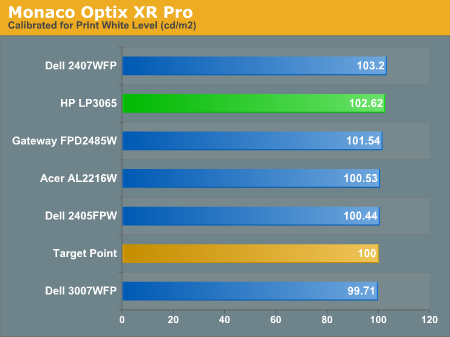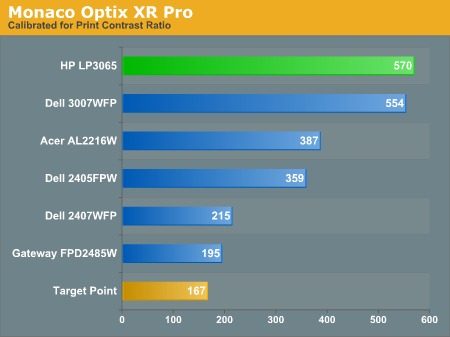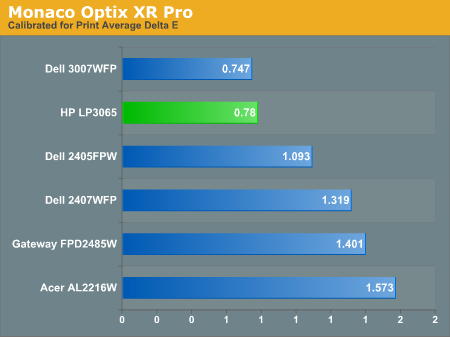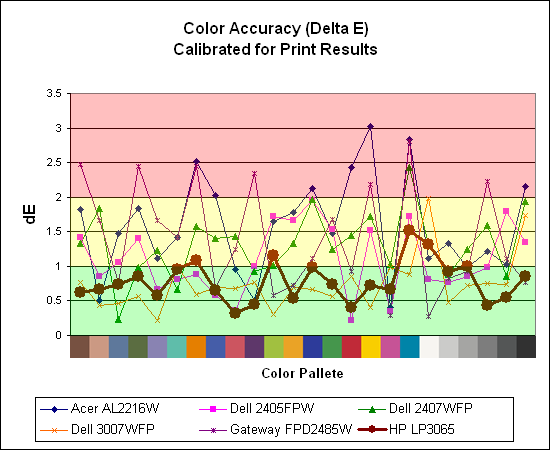HP LP3065: A new contender for the 30" throne
by Jarred Walton on March 22, 2007 7:00 AM EST- Posted in
- Displays
Printing Results
Brightness and Contrast Ratio
Using the standard calibration procedures works well if you only plan on using your computer with online data. In fact, you can generally set whatever brightness and contrast levels you want and then let the calibration software adjust the color profile as appropriate (although depending on the display certain settings will produce more or less accurate colors). However, many image professionals also have a need to match colors between their computer displays and their cameras and printers, and what works well for computing purposes often isn't the best suited for doing other image related work. To help people who work in such areas match their computer colors to their paper colors better, some standards were established. Generally speaking for print work the standard is a gamma of 2.2 (some people recommend 1.8, but we'll use 2.2), a black point of 0.60 cd/m2, and a white point of 100 cd/m2.
Finding the appropriate settings to reach these levels can be a time-consuming process. Numerous iterations through the calibration process are required in order to end up with the desired white point, and on some LCDs it might not even be possible to reach a satisfactory result. We were unable to get both an accurate white point and an accurate black point according to printing requirements (our black levels always ended up darker than they were supposed to be) but eventually we did manage to get near the desired 100 cd/m2 white point on all of the tested displays. This required adjusting the individual color levels on most of the displays, but the Dell 3007WFP and HP LP3065 lack this option so we simply reduced the brightness levels. Here are the settings we ended up using:
Dropping just the brightness on the Gateway FPD2485W and Dell 2407WFP did not reach the required white point, in the case of the former not by a long shot. We also found that dropping the brightness level to zero and then further reducing the color levels did not generate desirable results. We were most successful when we set the color levels to a moderate value and then tweaked the brightness and color levels as necessary to get the desired result. Here's how the brightness and contrast ratios changed with these tweaks.



We were not attempting to get 100% accuracy on the white point, but further tuning of the various displays would have likely made it possible to get closer to 100 cd/m2. The primary goal was to merely get the white point down to near 100 cd/m2 if possible. The target black point on the other hand is much more difficult to achieve once we have reached the target white point. Due to the reduced brightness level, contrast ratios are lower, but that is expected with print material. For reference, we have included the target values in the above graphs, so the greater the deviance of the display from the targeted value, the less suitable a display becomes for print work. Having calibrated the displays for printing, let's see how they actually fare.
Color Accuracy
Given the importance of accurate colors for printing work, we have adjusted the Delta E scale appropriately. A Delta E of less than 1.0 is definitely the goal here, and 1.0 to 2.0 is merely acceptable. Scores above 2.0 basically mean that the display is not fit for printing professionals.


The 30" displays definitely come into their own in this particular test, not only because they are far easier to calibrate (you just turn down the brightness level) but also because they score very well. The Dell 3007WFP and HP LP3065 are clearly the best displays for printing work, with very low average Delta E scores. In fact, the worst Delta E that the HP registers is only 1.52, and only five of the tested colors have a Delta E of 1.0 or more. Whether it's the overall quality of the displays or simply the S-IPS panels on the 30" LCDs, the fact is that these displays appear to be targeted more at professionals than any of the others. Considering the cost, that's probably not too surprising.
Brightness and Contrast Ratio
Using the standard calibration procedures works well if you only plan on using your computer with online data. In fact, you can generally set whatever brightness and contrast levels you want and then let the calibration software adjust the color profile as appropriate (although depending on the display certain settings will produce more or less accurate colors). However, many image professionals also have a need to match colors between their computer displays and their cameras and printers, and what works well for computing purposes often isn't the best suited for doing other image related work. To help people who work in such areas match their computer colors to their paper colors better, some standards were established. Generally speaking for print work the standard is a gamma of 2.2 (some people recommend 1.8, but we'll use 2.2), a black point of 0.60 cd/m2, and a white point of 100 cd/m2.
Finding the appropriate settings to reach these levels can be a time-consuming process. Numerous iterations through the calibration process are required in order to end up with the desired white point, and on some LCDs it might not even be possible to reach a satisfactory result. We were unable to get both an accurate white point and an accurate black point according to printing requirements (our black levels always ended up darker than they were supposed to be) but eventually we did manage to get near the desired 100 cd/m2 white point on all of the tested displays. This required adjusting the individual color levels on most of the displays, but the Dell 3007WFP and HP LP3065 lack this option so we simply reduced the brightness levels. Here are the settings we ended up using:
| Calibrated for Print Settings Gamma 2.2, White 100 cd/m2, Black 0.60 cd/m2 |
||||||
| Acer AL2216W | Dell 2405FPW | Dell 2407WFP | Dell 3007WFP | Gateway FPD2485W | HP LP3065 | |
| Brightness | 80 | 50 | 100 | 25 | 100 | 91 |
| Contrast | 80 | N/A | N/A | N/A | 100 | N/A |
| Red | 40 | 7 | 49 | N/A | 32 | N/A |
| Green | 39 | 10 | 50 | N/A | 32 | N/A |
| Blue | 39 | 11 | 46 | N/A | 32 | N/A |
Dropping just the brightness on the Gateway FPD2485W and Dell 2407WFP did not reach the required white point, in the case of the former not by a long shot. We also found that dropping the brightness level to zero and then further reducing the color levels did not generate desirable results. We were most successful when we set the color levels to a moderate value and then tweaked the brightness and color levels as necessary to get the desired result. Here's how the brightness and contrast ratios changed with these tweaks.



We were not attempting to get 100% accuracy on the white point, but further tuning of the various displays would have likely made it possible to get closer to 100 cd/m2. The primary goal was to merely get the white point down to near 100 cd/m2 if possible. The target black point on the other hand is much more difficult to achieve once we have reached the target white point. Due to the reduced brightness level, contrast ratios are lower, but that is expected with print material. For reference, we have included the target values in the above graphs, so the greater the deviance of the display from the targeted value, the less suitable a display becomes for print work. Having calibrated the displays for printing, let's see how they actually fare.
Color Accuracy
Given the importance of accurate colors for printing work, we have adjusted the Delta E scale appropriately. A Delta E of less than 1.0 is definitely the goal here, and 1.0 to 2.0 is merely acceptable. Scores above 2.0 basically mean that the display is not fit for printing professionals.


The 30" displays definitely come into their own in this particular test, not only because they are far easier to calibrate (you just turn down the brightness level) but also because they score very well. The Dell 3007WFP and HP LP3065 are clearly the best displays for printing work, with very low average Delta E scores. In fact, the worst Delta E that the HP registers is only 1.52, and only five of the tested colors have a Delta E of 1.0 or more. Whether it's the overall quality of the displays or simply the S-IPS panels on the 30" LCDs, the fact is that these displays appear to be targeted more at professionals than any of the others. Considering the cost, that's probably not too surprising.










44 Comments
View All Comments
lawrenpx - Saturday, December 4, 2010 - link
Has anyone been able to get the Matrox TripleHead2Go Digital to work with the HP LP3065 in either Linux Redhat or PC Windows? When I connect my monitors all I get is a blinking green light on the monitor which I believe means no signal. Perhaps I need to get a Linux driver but I can't find any. ThanksKeithP - Thursday, March 22, 2007 - link
While I understand some people can't wait for technology, it seems we are pretty close to seeing 120Hz refresh rates and LED backlighting. Given that, I think spending a bunch of money on a large LCD display may not be the best move.Of course, if you can't wait, the HP and Dell seem pretty nice.
JarredWalton - Thursday, March 22, 2007 - link
120Hz refresh rates will require something other than dual-link DVI in order to function. Right now, it's a matter of bandwidth. DVI runs at 165 MHz, which means that single-link maxes out at around 1920x1200 and dual-link maxes out at twice that (3840x2400). It will hopefully happen at some point, but we need a new input standard that provides more bandwidth first.chizow - Thursday, March 22, 2007 - link
Thanks for including an input lag comparison Jarred. Another suggestion to test is something I saw done by just an average user. He found a website or program that simply had an atomic clock or something that displayed current time down to the millisecond. Then he just used that to capture his comparison ISO from a digital camera. Essentially it gave him the exact difference in milliseconds between each panel without having to calculate the difference based on frame rates or discounting partial frames etc.The additional DVI inputs on the HP are nice though and hopefully your suggestions about future inputs are implemented in future 30" panels. One question though about the different inputs and resulting display resolutions. Are you able to control panel resolution using the panel itself? Or is that all controlled by the input device? I'd like to know if non-2560 input resolutions are upscaled to 2560 or if the panel displays them 1:1 with black bars. I know for PC inputs this should work with all Nvidia cards, but if you connected a PS3 via HDMI > DVI converter what display resolution would you get?
chizow - Thursday, March 22, 2007 - link
Thought about this some more. Would you get a corrupted display since the PS3 output isn't dual-link? Would be kind of a bummer but it makes sense.......Chucko - Thursday, March 22, 2007 - link
Amen on getting stuff reviewed sooner, this monitor has been out forever. Thanks for the review, great job!JarredWalton - Thursday, March 22, 2007 - link
It takes time to get products, especially when you're (re)launching a segment. The display began shipping in quantity around December, so it's been about three months. "Forever"? Possibly for some markets, but the fact is nothing new has come out in the 30" LCD market after this launch, and it's still good to have results in for future reviews. Hopefully I will be able to get earlier releases on future displays. :)JarredWalton - Thursday, March 22, 2007 - link
Forgot to say that when using a single-link DVI connection (which is what the PS3 uses), there was display corruption - or even a blank screen - up until Windows loaded. I booted - or tried to boot - a PC with Linux (again on a single-link connection). I didn't get any signal at all. It might be possible to get it to work if you set up Linux on a different display and then after configuring X for 1280x800 switch to the LP3065, but basically HP doesn't officially support single-link DVI. I would venture to say that a PS3 wouldn't work at all with the display... or an Xbox 360 or anything else that doesn't support 2560x1600 or possibly 1280x800.Renoir - Thursday, March 22, 2007 - link
Single-link DVI would appear to be a bit of a grey area. Why would HP go to the hassle and expense of including an HDCP cryptorom and then not allow you to easily utilise it over a single-link. I say "easily" because although you suggest it's possible you haven't managed to get it working.Does this mean that the display can "scale" 1280x800 despite not having an actual scaler because it fits so easily into 2560x1600? Stupid question maybe but just wanna make sure I understand what was meant by that.
AFAIK the ICT only affects the analogue outputs and High def dvd versions of powerdvd etc require HDCP on any digital outputs.
This issue is clear as mud. Would be great if you could find out what the deal is with HDCP content on this display!
JarredWalton - Friday, March 23, 2007 - link
I don't have any Blu-ray or HD-DVD drives, so I haven't been able to test. Given that HDCP support is now available on a lot of monitors, it's reasonable to say that older DVI ports don't support it, so ICT would affect them. The whole HDCP + Dual-link is this messed up area, as HDCP was originally created for HDMI and single-link.Of course, my technical opinion is that HDCP is just a joke and a waste of time and money anyway. Gee, how long did it take for people to figure out a way to decrypt Blu-ray and HD-DVD content? Thank goodness we all "need" HDCP cards and such now!
As for the 1280x800 support, the monitor fills the screen with content, but it's just a straight doubling of pixels. The Dell 3007 does the same thing. I guess that was easy enough to implement without any special hardware. All other scaling... well, there isn't any in the monitor. The GPU handles scaling (I recommend NVIDIA *strongly* here, as the ATI scaling is not quite as full-featured).
Anyway, I should be getting a laptop with a Blu-ray drive in the near future for review, so I'm going to hopefully be able to test dual-link plus Blu-ray output. Since no content currently uses ICT, though, it doesn't really matter. Frankly, if they ever enable ICT, a lot of people will be pissed.